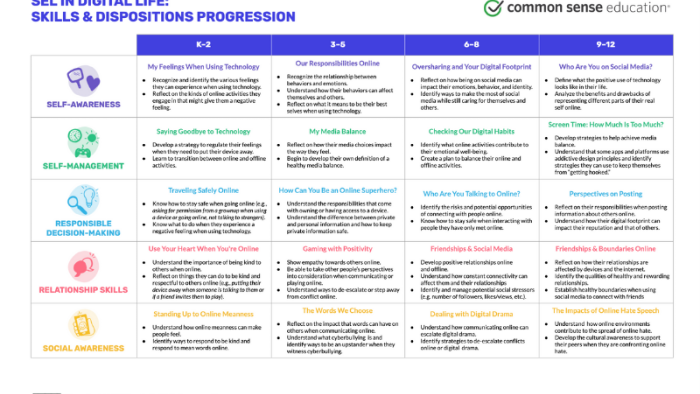Help your students develop the SEL skills they'll need to navigate the digital world.

Media and technology are central to how young people learn, socialize, and participate in the world. This makes it all the more important to consider how our student’s digital lives can impact their social and emotional well-being. We've prepared this guide to help you navigate this world where digital citizenship and social and emotional learning are deeply intertwined.
Read on to find answers to teachers' most commonly asked questions about social and emotional learning (SEL), along with information on how it fits your students' digital lives. To see our full collection of K–12 SEL activities, visit our SEL in Digital Life Resource Center. For full, research-based lessons that connect SEL with digital well-being, try our middle and high school lesson collections. And for some ideas and resources for quick implementation, see our Easy Ways to Connect SEL to Common Digital Dilemmas.
Use these links to jump to any section below:
- What is social and emotional learning?
- Why is social and emotional learning important?
- How can I teach SEL and digital citizenship to my students?
- Are there learning standards for SEL?
- How does technology impact social and emotional learning?
- What are the connections between digital citizenship and SEL?
- What are examples of SEL skills and dispositions that are unique to digital life?
- What are some best practices for teaching SEL?
- How can I teach SEL in an equity-oriented way?
- How can my school align its digital citizenship and SEL strategies?
What is social and emotional learning?
Social and emotional learning (SEL) is the process that all individuals go through as they develop the intrapersonal and interpersonal skills that will help them thrive -- in their own lives, as members of their communities, and in the world at large.
Why is social and emotional learning important?
Very simply, students need social and emotional learning skills to succeed in school and in life. Research has shown that school-wide implementations of SEL can lead to improved academic performance, decreased conflict between students, and can help students feel more invested in their school communities.
How can I teach SEL and digital citizenship to my students?
Our SEL in Digital Life Resource Center has everything you'll need to get started with social and emotional learning in the digital world. In the resource center, you'll find CASEL-aligned short activities, teaching guides, professional development resources, and family engagement materials.
Because engaging families and caregivers is such an essential piece of successful SEL implementation, we've included a set of conversation starters you can send to your students’ grown-ups so that they can practice what they learned in school at home.
Are there learning standards for SEL?
The SEL framework developed by the Collaborative for Academic, Social and Emotional Learning (CASEL) is widely used by educators as a resource to help bring SEL to their classrooms and schools. Some states, such as Wisconsin, have drafted a statewide framework and guidance for teaching SEL. Unfortunately, as of yet, most states and the federal government haven't developed this kind of detailed guidance. Because of this, the implementation of social-emotional learning can vary widely across school sites.
All of the resources created by Common Sense Education, including our SEL in Digital Life activities, are aligned to the CASEL framework and five core competencies for social and emotional learning:
- Self-Awareness
- Self-Management
- Responsible Decision-Making
- Relationship Skills
- Social Awareness
How does technology impact social and emotional learning?
Whether for learning or socializing, young people will undoubtedly face social and emotional challenges that are unique to using technology in their daily lives. For example, we can relate to how media use -- and often too much of it -- can have a direct impact on our emotional well-being. But the social and emotional challenges that students face when they use technology go beyond the individual.
For instance, communicating on digital platforms can make it more likely for people to be mean. And in a survey from Common Sense, the frequency with which young people reported encountering hateful content online was substantially higher today than it was in 2018. Unfortunately, the research also found that the young people most likely to encounter this kind of content are also those who are most likely to be the targets of online hate.
These unique types of challenges highlight the importance of teaching digital citizenship and SEL in an integrated way.
What are the connections between digital citizenship and SEL?
It might be common for teachers and schools to teach only SEL or only digital citizenship, or to teach them both, but separately. But it's important to know that SEL and digital citizenship can be very impactful when taught together. While the two content areas aren't interchangeable, they can definitely complement one another other.
It's best to think of digital citizenship as a specific context where social and emotional learning can take place. Digital citizenship calls attention to the unique challenges that students encounter when navigating the digital world. At the same time, it highlights the unique sets of skills and dispositions that students can use to navigate these challenges in a safe and responsible way. And when students put digital citizenship into practice, they're effectively using social and emotional strategies to address the uniqueness of their digital lives.
Digital citizenship helps SEL be more effective by making SEL more responsive to the demands and opportunities that technology brings into student’s lives.
What are examples of SEL skills and dispositions that are unique to digital life?
Technology's impact on students' social and emotional well-being can vary across age and levels of development. It's important to help your students learn the skills that are most important to them, whether it's understanding how devices affect their feelings or how social media impacts their friendships, just to name a few.
The table below outlines the K-12 SEL skills and dispositions covered in the Common Sense SEL in Digital Life activities. You can also click to open the table in a Google Doc.

What are some best practices for teaching SEL?
The best way to teach SEL is to implement a formal curriculum that also includes opportunities for family engagement. Unfortunately, many schools and districts across the country don't have a clear program for teaching SEL. This type of uneven implementation can have unintended consequences and exacerbate educational disparities, especially among students of color.
If there isn't a formal SEL curriculum or strategy at your school, you can still teach SEL! As you start, it's important to implement SEL strategies that follow a culturally responsive pedagogy. Our SEL in Digital Life activities are a great way to get started, but also keep the following tips in mind:
- Be sure to define what an equity-centered approach to SEL looks like in your classroom or school community.
- Collaborate with your colleagues to develop a joint understanding of how you're addressing students' social and emotional learning. This is particularly important when aligning on strategies for sensitive issues like conflict resolution and student discipline.
- Establish a positive classroom culture early on by engaging students in conversations about how they want to feel when they're learning, playing, and working together.
- Check in with students periodically to reflect on how well your classroom and community are working together toward achieving a positive classroom culture.
Use this movie guide to explore issues of SEL and identity.

Whale Rider and SEL: A Movie Guide and Lesson Plan for Your Classroom
How can I teach SEL in an equity-oriented way?
When teaching SEL it is important that your focus goes beyond classroom management and student discipline. Dena Simmons, a scholar and practitioner who specializes in SEL and equity, explains that social emotional learning interventions that focus squarely on these two areas can end up reinforcing “failure narratives”. When unchecked, these negative narratives can feed educators' implicit biases and lead them to believe that some students, often students of color, need more SEL skills to regulate their behavior and emotions as compared to their peers. The impact of this cycle of negative narratives and implicit biases can be harmful and result in unequal disciplinary outcomes, or in students of color internalizing a negative self-image.
To learn more about how to make your approach to SEL more equity-centered, you can read more of Dr. Simmons’s work on this topic. Our team has also curated a helpful list of the best social- and cultural-literacy resources from around the web, which could be useful as you develop an SEL implementation strategy.
How can my school align its digital citizenship and SEL strategies?
A set of policy recommendations drafted by the Committee for Children suggests it is important to align digital citizenship to ongoing SEL initiatives and to make clear how SEL strategies are foundational to how digital citizenship is taught to students. How you align digital citizenship to SEL might look different depending on whether you are a teacher or an administrator:
If you're a teacher interested in addressing digital citizenship and SEL in your classroom, you can check out our resources:
- Digital Well-Being Lesson Collections: These research-based lesson collections—one set for middle and one for high school—address SEL and digital well-being at the same time. Because so much of young people's lives are online, these lessons are a focused way to get at critical issues, like how devices can reinforce negative thinking and how to center your values while using technology.
- SEL in Digital Life Resource Center: If you want CASEL-aligned quick activities for each grade band, family conversation starters, and professional development resources all in one place, this is it! Plus, we have SEL-related movie guides with active viewing printables. Address concepts like responsible decision-making, relationship skills, and social awareness with these activities.
If you're an administrator or curriculum specialist looking to develop an initiative that clearly connects SEL and digital citizenship, try these resources:
- Online Safety + Social and Emotional Learning: Wisconsin's Department of Public Instruction developed a useful infographic, as well as a curriculum crosswalk that outlines the connection between SEL and the state's information and technology literacy standards.
- EdWeb: Social Media Literacy and Mental Health: This recorded webinar, based on the latest research, covers the intersection of social media use and well-being.







